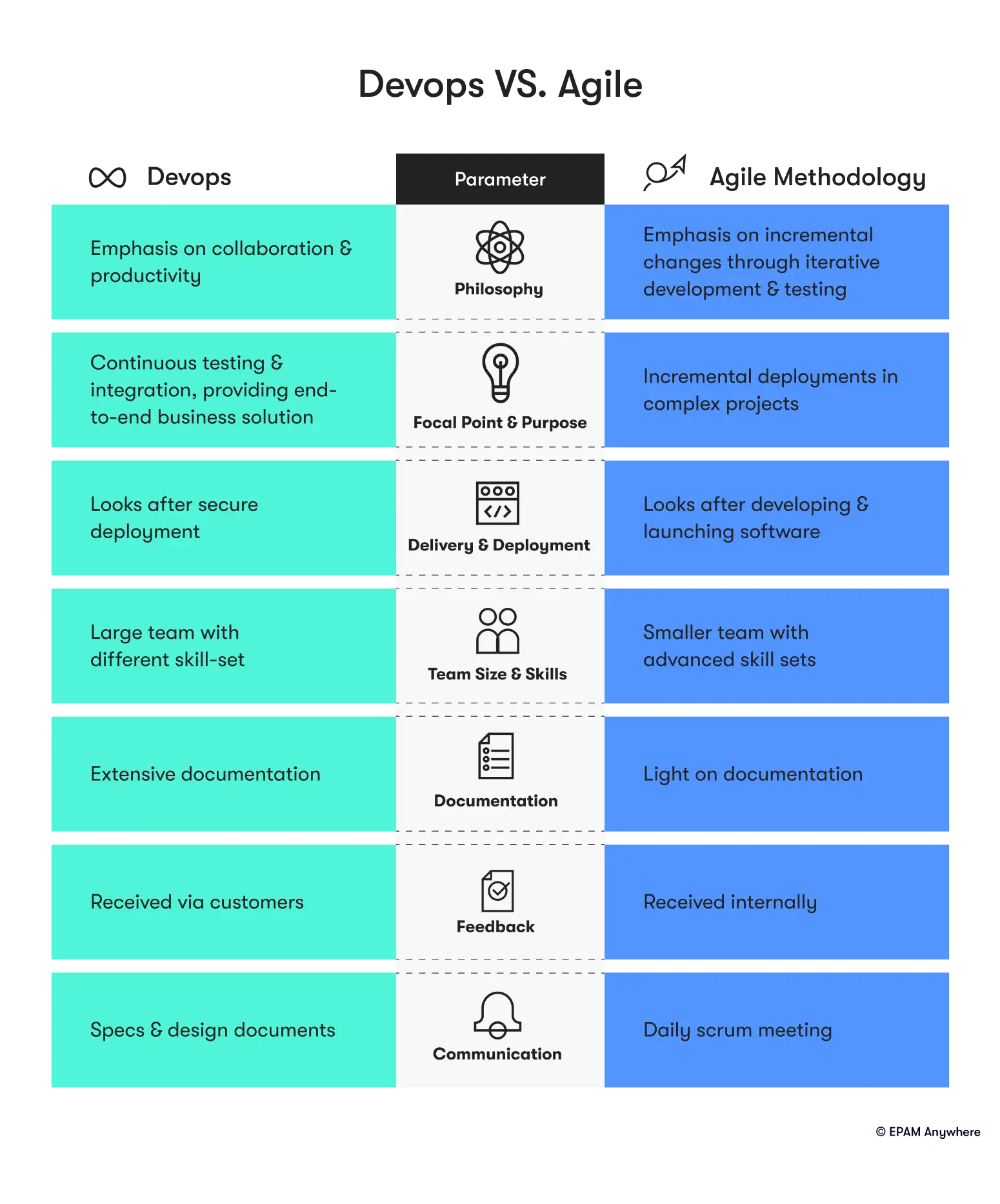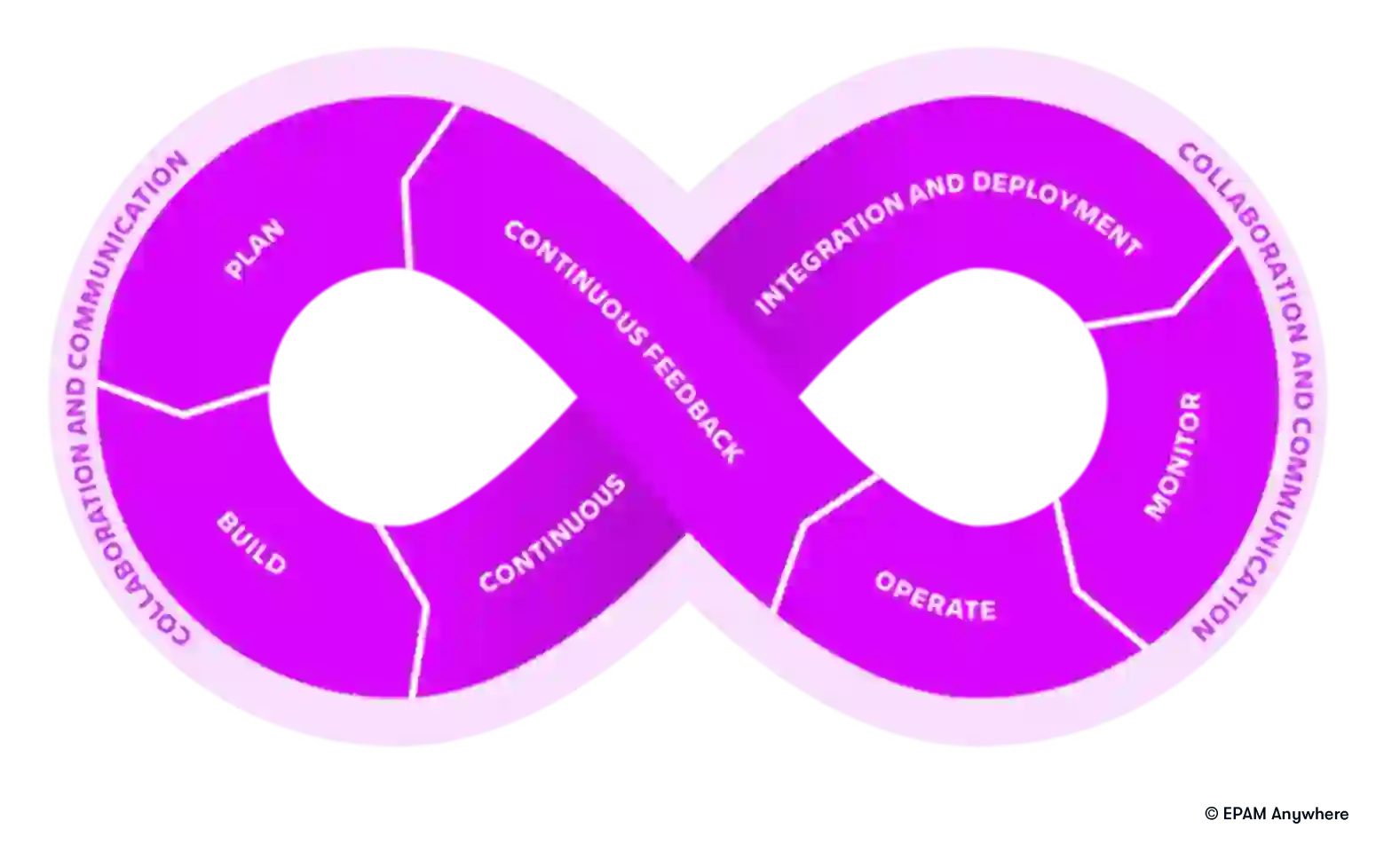Agile and DevOps do not need to compete. While both methodologies have different approaches to software development and project management, they can easily merge without any significant problems. In most cases, a high-functioning enterprise project only begins to thrive when teams collaborate across both frameworks.
Still, many think DevOps and agile cannot work together, as they have fundamentally different values throughout the development lifecycle. It raises the question: how can agile and DevOps interrelate?
Let's explore both methodologies and some common misconceptions regarding the merging of agile and DevOps.
What is agile?
Agile refers to a set of software development and project management practices that focus on continuous, iterative improvements. Teams work with small, incremental releases, leading to a development environment that can adapt to changes and feedback.
Since projects do not follow bulk release timelines, it allows for a more customer-focused outlook to project growth. With constant evaluation and delivery of component pieces, agile creates a robust and efficient software development lifecycle with non-stop value-adding. Stakeholders and management can review and track the progress of various sprints, introducing accountability and adaptability into the cultural mindset of an organization.
The manifesto for agile software development lists 12 core principles. Each principle emphasizes customer satisfaction, the acceptance of continuous change, the frequent delivery of smaller components, and management built around individuals, not tools or processes. It is an efficient, quality-driven approach to software development when creating various applications for healthcare, finance, education, and more.
Key agile roles
Agile attempts to build holistic units that bring specialized individuals into a functional, organized team structure. The following are the key roles in an agile team:
- Product Owner: This is the principal role in an agile team setup. The product owner is the one who drives the overall product strategy and is accountable for both the quality of deliverables and the product’s market/user reception.
- Scrum Master: An agile team needs a leader, and the Scrum master takes the high-level instruction of the product owner and delegates any required tasks. Coaching, team organization, and administrative tasks are part of the role.
- Development Members: An agile team primarily consists of development members who engage in the product's creation. Not every member may be an engineer, but the role encompasses those who participate in sprints.
- Stakeholders: An agile team will include numerous product development roles that support the overall direction of a project. The Product Owner represents the stakeholders and upholds the long-term project vision. In support of that mission, business executives, clients, and investors will help address issues within the development lifecycle.
Key technologies used
Due to the high level of coordination needed for complicated projects with simultaneous work requirements, service providers offer agile development tools. Most technologies fit within known project management frameworks such as Scrum or Kanban.
Popular agile tools include:
- Jira: Work management and issue tracking software
- GitHub: A code hosting platform
- Planbox: A modular platform for lifecycle efficiency
- Active Collab: Project management solutions with digital communication applications
What is DevOps?
DevOps is a combined set of practices that merges software development (dev) with operations (ops). It is a methodology designed to optimize an organization's delivery and management processes. Speed and efficiency provide competitive market advantages.
In relation to agile, DevOps does not silo teams or focus on incremental evolution. Instead, it attempts to integrate various development stages for better velocity. Product and process meld together, with less distance between admins and developers. Both success and failure are shared.
Four key principles reflect the core values of the DevOps methodology: automation, communication, efficiency, and continuous feedback. Those principles help build an infinity loop representing six phases of the DevOps lifecycle. Each phase symbolizes constant improvement and the need for collaboration.

Key DevOps roles
DevOps favors cross-functional teams with clearly defined roles that manage each aspect of a product build. Large enterprises may add specialized DevOps job responsibilities, but this is a standard structure for most DevOps teams:
- The DevOps Evangelist: The DevOps Evangelist holds a primary leadership role, helping advocate for the DevOps methodology and promoting its benefits to a company.
- The Automation Architect: Since project optimization relies on automation, the Automation Architect defines team operation requirements and ensures the continuous deployment of the project's infrastructure.
- The Software Tester: To streamline delivery, the Software Tester will test features throughout the entire development lifecycle to further increase team velocity.
- The Release Manager: Release Managers oversee the entire project timeline, providing integrated daily activities that support project completion.
- Security and compliance professionals: Security is often an afterthought, especially with such rapid product delivery. Security and compliance professionals integrate security practices during the project timeline.
In addition, a product owner oversees each department and maintains the project's overall vision.
Key DevOps technologies
The right technology allows teams to capture the benefits of the DevOps methodology. DevOps services can help with implementation, and different service providers offer tools that support the automation and collaboration of the DevOps product lifecycle:
- Maven: Automation tools for Java projects
- Git: Software tools for tracking changes to source code
- Jenkins: Automation tools that facilitate continuous integration
- Jira: Tracking software for bugs
- Bitbucket: Source code repository for CI/CD optimization
What is a common misconception about agile and DevOps?
Agile and DevOps have much in common. In fact, DevOps grew as an offshoot (or improvement) of agile, as many industry leaders found dysfunction in IT and software development. While incremental improvements support quality products, the competing objectives of individual IT workers lowered overall performance.
To remedy the problem, developers proposed the more integrated approach of DevOps. Of course, the new philosophy offered different core values, which caused a split between two opposing communities.
Developers grappled with what looked like conflicting philosophies, leading to the most common misconception about agile and DevOps: that they don’t interrelate.
On the surface, the pundits have much to draw on. DevOps engineers focus on software scalability, speed, and team integration. Agile focuses on the slower, iterative process of software development, with more emphasis on continuous testing.
More importantly, Agile silos individuals while DevOps integrates. Without the operability of DevOps, infrastructure responsibility falls to the wayside. But without the basic building blocks of the incremental, customer-focused method of agile, DevOps has no fundamental processes on which to stand.
The solution is to combine agile with DevOps. They are not interchangeable or mutually exclusive, but two sides of the same coin.
Agile and DevOps: the common ground
Although agile and DevOps differ in their approach, they both have the same goal: efficient software development and high-quality product releases. DevOps can fit within every phase of a product's lifecycle, building upon the manageable tasks outlined by agile. Agile relies on organization values, while DevOps relies on workflow through the delivery pipeline. Together, the two approaches improve development.
Beyond the cultural mindset both philosophies offer, there is a significant interrelation between agile and DevOps.
Continuous integration
Both agile and DevOps rely on continuous integration (CI) and continuous delivery (CD) to optimize the delivery lifecycle. Agile leverages small chunks of work that integrate into a cohesive whole, while DevOps automates code integrations to speed up release deployments according to business need. Together, they make a safe, reliable, and efficient pipeline.
Automated testing
Agile and DevOps both test, but in complementary ways. Agile uses specialized skill from individuals to create standards for testing that ensure quality. DevOps automates repetitive testing and builds in compliance with deployments. Together, more testing occurs as all individuals shoulder the responsibility of quality assurance (QA).
Modular design
Agile uses design principles that are modular and reusable, creating environments that promote experimentation. Likewise, using modular elements such as Git repositories or containers helps implement agile principles at scale.
Feedback cycles
Both methodologies emphasize adaptability. Agile uses sprints and Scrum as management processes, which include rapid feedback from all stakeholders. DevOps supports such feedback by automating and flagging failures. Together, the product quality improves according to customer expectations.
Development flow
Both agile and DevOps support management. Agile sets the stage for skills development, learning, and team contribution, while DevOps automates all operations tasks to increase collaboration and responsibility among dev teams. Together, team objectives are achieved with clear project and management flow.

How can you combine agile and DevOps?
While agile and DevOps can easily coexist, combining the two philosophies into a cohesive whole within an organization can be tricky. Use the following steps to create an efficient transition process to agile + DevOps:
Add DevOps in sprints
Agile divides all development phases into sprints outlined by a scrum framework, so start to add DevOps management into all sprint planning. Discuss product features in sprint meetings with DevOps present, and allow developers to inform the release schedule. Simple acts that promote team collaboration can improve an organization's culture shift.
Apply constant testing to all phases
Testing is one of the core commonalities between agile and DevOps, and it can function as a bridge between the two philosophies. Integrate QA into the entire development lifecycle, and automate testing when possible. Allow continuous testing to take on the same importance as continuous development.
Combine core technologies
Both agile and DevOps utilize particular tools that help achieve the specific goals of each product lifecycle. When possible, combine tools and offer learning opportunities to employees for new technologies. In addition, leverage management tools that align agile processes with the rapidity of DevOps.
Automate workflows
Automation can further combine DevOps with agile. For example, by completing elements and holding them in a repository, it is far easier for developers to complete modular components without sacrificing the velocity common to DevOps.
looking for a remote DevOps job?
Join EPAM Anywhere as a top DevOps engineer. Send your CV to get your perfect job-match.
Summary
Agile and DevOps do interrelate in that they allow individual software developers to become better collaborators. They provide a way to increase the speed of the development lifecycle without running into the complications associated with siloed engineers that work on disparate elements. When combined, the two methodologies support a robust project pipeline that results in a high-quality end product.
While it may seem that the iterative focus on software development offered by agile clashes with the collaborative mindset of DevOps, the two function well together. Cross-functional roles of DevOps support the implementation of agile, not harm it. When integrated together, workflow efficiency improves — a crucial advantage for any enterprise.

The EPAM Anywhere Editorial Team is an international collective of senior software engineers, managers and communications professionals who create, review and share their insights on technology, career, remote work, and the daily life here at Anywhere.
The EPAM Anywhere Editorial Team is an international collective of senior software engineers, managers and communications professionals who create, review and share their insights on technology, career, remote work, and the daily life here at Anywhere.
Explore our Editorial Policy to learn more about our standards for content creation.
read more




















